
Felix of Nantes (514-584) was a 6th-century Bishop of Nantes, France. He is venerated as a saint in the Catholic Church.

Felix of Nantes (514-584) was a 6th-century Bishop of Nantes, France. He is venerated as a saint in the Catholic Church.
Felix was married, and in 551 at the age of 37, he was made Bishop of Nantes while his wife became a nun. He then sold his patrimony on behalf of the poor, and built a cathedral within city walls as planned by his predecessor, Evemer. His municipal improvements at Nantes were praised in the poems of Venantius Fortunatus.
He often mediated between the people of Brittany and Frankish kings. [1] Guerech II, Count of Vannes, plundered the Diocese of Rennes and the Diocese of Vannes, and repulsed the troops which King Chilperic sent against him. At the entreaties of Bishop Felix, the count withdrew his forces and made peace.
Felix was at the Council of Paris in 557 and the Council of Tours in 567, where it was noted that some Gallo-Roman customs of ancestor worship were still being practiced. [2]
He died at the age of 70 on January 8, 584, having served as Bishop of Nantes for 33 years. His feast day in the General Roman Calendar is on July 7. [3]

Amandus, commonly called Saint Amand, was a bishop of Tongeren-Maastricht and one of the catholic missionaries of Flanders. He is venerated as a saint, particularly in France and Belgium.
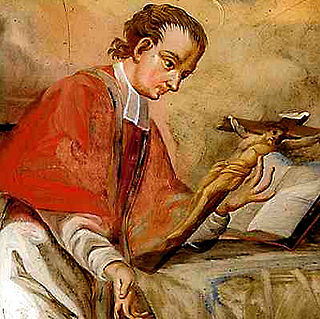
Saint Agricius, also Agritius was the first historically documented bishop of Trier.
Saint Aldric was Bishop of Le Mans in the time of Louis the Pious.

The Abbey of St Vaast was a Benedictine monastery situated in Arras, département of Pas-de-Calais, France.

Perpetuus was the sixth Bishop of Tours, serving from 460 to 490.

James O'Connor, S.J. was the first Catholic Bishop of the Diocese of Omaha, Nebraska.
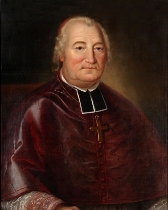
Pierre Denaut was the tenth bishop of the Roman Catholic diocese of Quebec and the last before it became an Archdiocese. He served as bishop from 1797 to 1806.
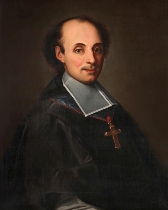
Louis-François Duplessis de Mornay was bishop of the diocese of Quebec from 1727 to 1733, although he never went to Canada. From a noble family, he joined the Capuchins. Appointed Vicar-General for Louisiana, he supervised the various orders conducting missions through correspondence.
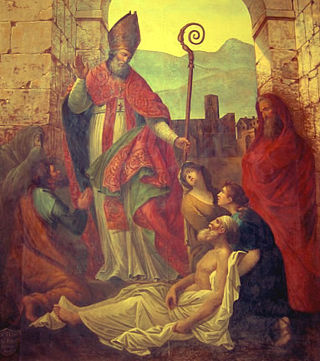
Saint Fulcran was a French saint. He was bishop of Lodève.

Richard Phelan, D.D. was an Irish-born prelate of the Roman Catholic Church who served as the fourth bishop of the Diocese of Pittsburgh in Pennsylvania, in the United States from 1889 to 1904.
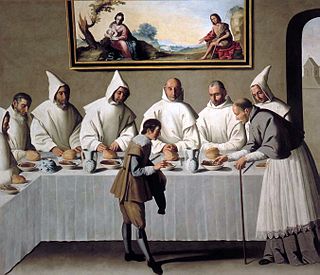
Hugh of Châteauneuf, also called Hugh of Grenoble, was the Bishop of Grenoble from 1080 to his death. He was a partisan of the Gregorian reform and opposed to the Archbishop of Vienne, later Pope Callixtus II.

Sainte-Anne-d'Auray is a commune in the Morbihan department of Brittany in north-western France. It is the third most popular pilgrimage site in France, after Lourdes and Lisieux.
Jacques-Maurice des Landes d’Aussac de Saint Palais was an American prelate of the Roman Catholic Church. He served as the fourth Bishop of Vincennes, from 1848 until his death.

Senones Abbey was a Benedictine abbey located in the valley of the Rabodeau, in the present village of Senones in Grand Est, France.
The Congregation of St. Vanne or Congregation of St. Vanne and St. Hydulphe (French: Congrégation de Saint-Vanne et Saint-Hydulphe was a Benedictine reform movement centered in the Duchy of Lorraine. It was formally established in 1604 on the initiative of Didier de La Cour, prior of the Abbey of Saint-Vanne near Verdun, a reformer of the Benedictine Order after the Council of Trent. The Abbey of St. Hydulphe at Moyenmoutier was a secondary centre of the reform.

Francis Patrick McFarland was an American Catholic bishop who served as the third Bishop of Hartford.

Sulpitius I was Bishop of Bourges. Often called Sulpitius Severus, the Severe, he is wrongly identified with Sulpicius Severus, the historian of Saint Martin of Tours.

The Sisters of Charity of St. Louis (SCSL) is a Roman Catholic religious congregation. It was founded for the education of poor girls, at Vannes in Brittany, in 1803, by Madame Molé, née de Lamoignon, at the suggestion of Antoine-Xavier Maynaud de Pancemont, Bishop of Vannes.
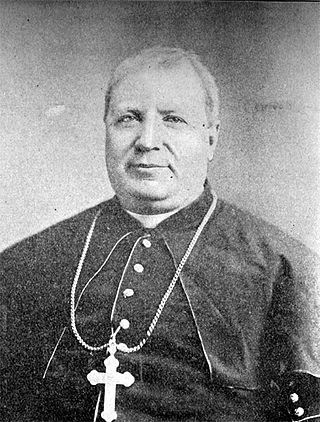
Michael Joseph O'Farrell was an Irish-born prelate of the Roman Catholic Church who served as the first bishop of the Diocese of Trenton in New Jersey from 1881 until his death in 1894.

According to late traditions, Clair was the first bishop of Nantes, France in the late 3rd century. He is venerated as a saint in the Catholic Church.
![]() This article incorporates text from a publication now in the public domain : Herbermann, Charles, ed. (1913). "Nantes (Nannetes)". Catholic Encyclopedia . New York: Robert Appleton Company.
This article incorporates text from a publication now in the public domain : Herbermann, Charles, ed. (1913). "Nantes (Nannetes)". Catholic Encyclopedia . New York: Robert Appleton Company.